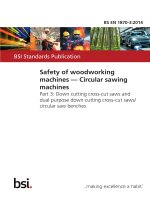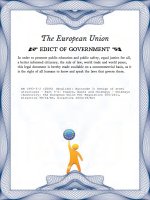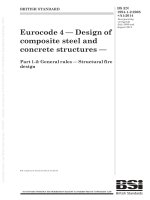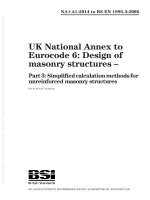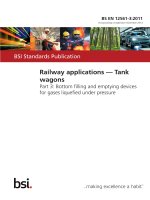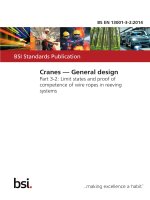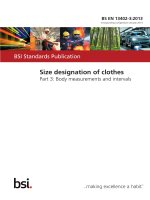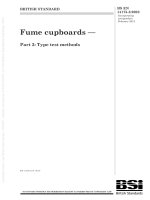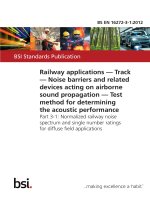Bsi bs en 16272 3 2 2014
Bạn đang xem bản rút gọn của tài liệu. Xem và tải ngay bản đầy đủ của tài liệu tại đây (1.04 MB, 18 trang )
BS EN 16272-3-2:2014
BSI Standards Publication
Railway applications — Track
— Noise barriers and related
devices acting on airborne
sound propagation — Test
method for determining the
acoustic performance
Part 3-2: Normalized railway noise spectrum
and single number ratings for direct field
applications
BS EN 16272-3-2:2014
BRITISH STANDARD
National foreword
This British Standard is the UK implementation of EN
16272-3-2:2014.
The UK participation in its preparation was entrusted to Technical
Committee RAE/2, Railway Applications - Track.
A list of organizations represented on this committee can be
obtained on request to its secretary.
This publication does not purport to include all the necessary
provisions of a contract. Users are responsible for its correct
application.
© The British Standards Institution 2014. Published by BSI Standards
Limited 2014
ISBN 978 0 580 76213 0
ICS 17.140.30; 93.080.30
Compliance with a British Standard cannot confer immunity from
legal obligations.
This British Standard was published under the authority of the
Standards Policy and Strategy Committee on 31 July 2014.
Amendments issued since publication
Date
Text affected
BS EN 16272-3-2:2014
EN 16272-3-2
EUROPEAN STANDARD
NORME EUROPÉENNE
EUROPÄISCHE NORM
July 2014
ICS 17.140.30; 93.080.30
English Version
Railway applications - Track - Noise barriers and related devices
acting on airborne sound propagation - Test method for
determining the acoustic performance - Part 3-2: Normalized
railway noise spectrum and single number ratings for direct field
applications
Applications ferroviaires - Voie - Dispositifs de réduction du
bruit - Méthode d'essai pour la détermination des
performances acoustiques - Partie 3-2 : Spectre de bruit
ferroviaire normalisé et indices uniques d'évaluation pour
des applications en champ direct
Bahnanwendungen - Oberbau - Lärmschutzwände und
verwandte Vorrichtungen zur Beeinflussung der
Luftschallausbreitung - Prüfverfahren zur Bestimmung der
akustischen Eigenschaften - Teil 3-2: Standardisiertes
Schienenverkehrslärmspektrum und Einzahl-Angaben für
gerichtete Schallfelder
This European Standard was approved by CEN on 30 April 2014.
CEN members are bound to comply with the CEN/CENELEC Internal Regulations which stipulate the conditions for giving this European
Standard the status of a national standard without any alteration. Up-to-date lists and bibliographical references concerning such national
standards may be obtained on application to the CEN-CENELEC Management Centre or to any CEN member.
This European Standard exists in three official versions (English, French, German). A version in any other language made by translation
under the responsibility of a CEN member into its own language and notified to the CEN-CENELEC Management Centre has the same
status as the official versions.
CEN members are the national standards bodies of Austria, Belgium, Bulgaria, Croatia, Cyprus, Czech Republic, Denmark, Estonia,
Finland, Former Yugoslav Republic of Macedonia, France, Germany, Greece, Hungary, Iceland, Ireland, Italy, Latvia, Lithuania,
Luxembourg, Malta, Netherlands, Norway, Poland, Portugal, Romania, Slovakia, Slovenia, Spain, Sweden, Switzerland, Turkey and United
Kingdom.
EUROPEAN COMMITTEE FOR STANDARDIZATION
COMITÉ EUROPÉEN DE NORMALISATION
EUROPÄISCHES KOMITEE FÜR NORMUNG
CEN-CENELEC Management Centre: Avenue Marnix 17, B-1000 Brussels
© 2014 CEN
All rights of exploitation in any form and by any means reserved
worldwide for CEN national Members.
Ref. No. EN 16272-3-2:2014 E
BS EN 16272-3-2:2014
EN 16272-3-2:2014 (E)
Contents
Foreword ...................................................................................................................................................................... 3
Introduction ................................................................................................................................................................. 4
1
Scope .............................................................................................................................................................. 5
2
Normative references .................................................................................................................................... 5
3
Terms and definitions ................................................................................................................................... 5
4
Normalized railway noise spectrum............................................................................................................. 6
5
Single-number rating of sound reflection index DLRI ................................................................................ 7
6
6.1
6.2
6.3
6.4
Single-number ratings of sound insulation index DLSI .............................................................................. 8
General ............................................................................................................................................................ 8
Acoustic elements ......................................................................................................................................... 8
Posts ............................................................................................................................................................... 8
Global .............................................................................................................................................................. 9
7
7.1
7.2
7.3
7.4
Single-number ratings of sound diffraction index difference DLΔDI ......................................................... 9
General ............................................................................................................................................................ 9
Single-number rating of sound diffraction index difference DLΔDI,refl ....................................................... 9
Single-number rating of sound diffraction index difference DLΔDI,abs .................................................... 10
Single-number rating of sound diffraction index difference DLΔDI,situ .................................................... 10
8
Expression of results .................................................................................................................................. 10
Annex A (informative) Guidance note on use of the single-number rating of sound reflection index
DLRI ............................................................................................................................................................... 12
Annex B (informative) Guidance note on use of the single-number rating of airborne sound insulation
index DLSI .................................................................................................................................................... 13
Annex C (informative) Guidance note on use of the single-number rating of sound diffraction index
difference DLΔDI ............................................................................................................................................ 14
2
BS EN 16272-3-2:2014
EN 16272-3-2:2014 (E)
Foreword
This document (EN 16272-3-2:2014) has been prepared by Technical Committee CEN/TC 256 “Railway
applications”, the secretariat of which is held by DIN.
This European Standard shall be given the status of a national standard, either by publication of an identical text or
by endorsement, at the latest by January 2015 and conflicting national standards shall be withdrawn at the latest by
January 2015.
Attention is drawn to the possibility that some of the elements of this document may be the subject of patent rights.
CEN [and/or CENELEC] shall not be held responsible for identifying any or all such patent rights.
This document has been prepared under a mandate given to CEN by the European Commission and the European
Free Trade Association.
This European Standard is one of the series EN 16272, Railway applications — Track — Noise barriers and related
devices acting on airborne sound propagation — Test method for determining the acoustic performance, as listed
below:
—
Part 1: Intrinsic characteristics — Sound absorption in the laboratory under diffuse sound field conditions;
—
Part 2: Intrinsic characteristics — Airborne sound insulation in the laboratory under diffuse sound field
conditions;
—
Part 3-1: Normalized railway noise spectrum and single number ratings for diffuse field applications;
—
Part 3-2: Normalized railway noise spectrum and single number ratings for direct field applications (the present
document);
—
Part 5: Intrinsic characteristics — In situ values of sound reflection under direct sound field conditions
(Technical Specification);
—
Part 6: Intrinsic characteristics — In situ values of airborne sound insulation under direct sound field
conditions.
According to the CEN-CENELEC Internal Regulations, the national standards organizations of the following
countries are bound to implement this European Standard: Austria, Belgium, Bulgaria, Croatia, Cyprus, Czech
Republic, Denmark, Estonia, Finland, Former Yugoslav Republic of Macedonia, France, Germany, Greece,
Hungary, Iceland, Ireland, Italy, Latvia, Lithuania, Luxembourg, Malta, Netherlands, Norway, Poland, Portugal,
Romania, Slovakia, Slovenia, Spain, Sweden, Switzerland, Turkey and the United Kingdom.
3
BS EN 16272-3-2:2014
EN 16272-3-2:2014 (E)
Introduction
This document is to be read in conjunction with prEN 16272-4, CEN/TS 16272-5 and EN 16272-6 and will be
applied only to situations as described in those documents (direct sound field).
As the two main intrinsic acoustic characteristics of noise barriers and related devices acting on airborne sound
propagation in a direct sound field, the sound reflection index and the sound insulation index, are frequency
dependent, there is a need to define a reference railway noise spectrum for test purposes.
Also the sound diffraction index difference, the main intrinsic acoustic characteristic of added devices, i.e. products
which may be added on the top of noise barriers and intended to contribute to sound attenuation acting primarily on
the diffracted sound field, is frequency dependent and there is an analogous need to define a reference railway
noise spectrum for test purposes.
This European Standard defines the basic properties of railway noise measured at the rail track side in terms of a
characteristic normalized railway noise spectrum which is needed to evaluate single-number ratings of noise
barriers and related devices acting on airborne sound propagation, except those used in reverberant conditions,
e.g. inside tunnels or deep trenches.
4
BS EN 16272-3-2:2014
EN 16272-3-2:2014 (E)
1
Scope
This European Standard specifies a normalized railway noise spectrum for the evaluation and assessment of the
acoustic performance of devices designed to reduce airborne railway noise near railways.
All noise reducing devices different from noise barriers and related devices acting on airborne sound propagation,
e.g. devices for attenuation of ground borne vibration and on board devices, are out of the scope of this European
Standard.
2
Normative references
The following documents, in whole or in part, are normatively referenced in this document and are indispensable for
its application. For dated references, only the edition cited applies. For undated references, the latest edition of the
referenced document (including any amendments) applies.
prEN 16272-4:2014, Railway applications — Track — Noise barriers and related devices acting on airborne sound
propagation — Test method for determining the acoustic performance — Part 4: Intrinsic characteristics — In situ
values of sound diffraction under direct sound field conditions
CEN/TS 16272-5:2014, Railway applications — Track — Noise barriers and related devices acting on airborne
sound propagation — Test method for determining the acoustic performance — Part 5: Intrinsic characteristics —
In situ values of sound reflection under direct sound field conditions
EN 16272-6:2014, Railway applications — Track — Noise barriers and related devices acting on airborne sound
propagation — Test method for determining the acoustic performance — Part 6: Intrinsic characteristics — In situ
values of airborne sound insulation under direct sound field conditions
3
Terms and definitions
For the purposes of this document, the following terms and definitions apply.
3.1
noise barrier
noise reducing device, which obstructs the direct transmission of airborne sound emanating from railways
Note 1 to entry:
It may either span or overhang the railway.
Note 2 to entry:
Noise barriers are generally made of acoustic and structural elements (3.3 and 3.4).
3.2
cladding
noise reducing device, which is attached to a wall or other structure and reduces the amount of sound reflected
Note 1 to entry:
Claddings are generally made of acoustic and structural elements (3.3 and 3.4).
3.3
acoustic element
element whose primary function is to provide the acoustic performance of the device
3.4
structural element
element whose primary function is to support or hold in place acoustic elements
5
BS EN 16272-3-2:2014
EN 16272-3-2:2014 (E)
Note 1 to entry:
In some noise barriers the acoustic function and the structural function cannot be clearly separated and
attributed to different components.
3.5
added device
added component that influences the acoustic performance of the original noise-reducing device (acting primarily
on the diffracted energy)
3.6
normalized railway noise spectrum
spectrum that is used for the calculation of the acoustic performance of noise barriers and related devices acting on
airborne sound propagation near railways, in terms of single-number ratings of sound reflection index, sound
insulation index and sound diffraction index difference, as applicable
Note 1 to entry:
The spectrum is expressed in terms of relative A-weighted sound pressure levels in decibels, for one-third
octave bands, Li, in the frequency range from 100 Hz to 5 kHz.
3.7
one-third octave bands level
Li
relative A-weighted sound pressure levels in decibels, of a normalized railway noise spectrum for one-third octave
bands with centre frequency range fi
4
Normalized railway noise spectrum
The normalized railway noise spectrum shown in Table 1 shall be used to assess the acoustic performance of
noise barriers and related devices acting on airborne sound propagation near railways.
6
BS EN 16272-3-2:2014
EN 16272-3-2:2014 (E)
Table 1 — Normalized railway noise spectrum
5
fi
Li railways
Hz
dB
100
- 27
125
- 25
160
- 23
200
- 21
250
- 19
315
- 17
400
- 15
500
- 13
630
- 12
800
- 11
1 000
- 10
1 250
-9
1 600
-9
2 000
-9
2 500
-9
3 150
- 10
4 000
- 13
5 000
- 17
Single-number rating of sound reflection index DLRI
A single-number rating shall be derived to indicate the performance of the product related to sound reflection index.
The individual sound reflection index values shall be weighted according to the normalized railway noise spectrum
defined in Table 1.
The single-number rating of sound reflection index DLRI, in decibels, is given by:
18
0 ,1Li
∑ RI i ⋅10
DLRI = −10 × lg i =m 18
10 0,1Li
∑
i =m
(1)
where
RIi
is the sound reflection index measured in front of the acoustic elements, in the i-th one-third octave band;
m
is the number of the lowest reliable one-third octave frequency band;
Li
is the relative A-weighted sound pressure levels (dB) of the normalized railway noise spectrum, as
defined in Table 1, in the i-th one-third octave band.
For product qualification tests in laboratory conditions, the single number rating DLRI shall be calculated for samples
of minimum dimensions of 4 m x 4 m.
7
BS EN 16272-3-2:2014
EN 16272-3-2:2014 (E)
The RIi values to be inserted in Formula (1) are the spatial averaged values of the sound reflection index according
to Table 2 of CEN/TS 16272-5:2014.
In some cases the ratio of the summation terms in the expression of DLRI can exceed 1 which precludes the correct
calculation of DLRI. For this reason the maximum value of this ratio shall be limited to 0,99.
NOTE
6
Annex A provides guidance to the use of the single-number rating of sound reflection index.
Single-number ratings of sound insulation index DLSI
6.1 General
Whenever possible, three single-number ratings shall be derived from measurements to indicate the performance
of the product related to sound insulation index: one for acoustic elements, one for posts (if applicable) and a global
rating. The individual sound insulation index values coming from element scanning and post scanning shall be
weighted according to the normalized railway noise spectrum defined in Table 1.
6.2 Acoustic elements
The single-number rating for acoustic elements DLSI,E, in decibels, is given by:
DLSI , E
18 0,1Li −0,1SI E ,i
∑10 10
= −10 × lg i =m 18
10 0,1Li
∑
i =m
(2)
where:
SIE,i
is the sound insulation index measured in front of the acoustic elements, in the i-th one-third octave
band;
m
is the number of the lowest reliable one-third octave frequency band;
Li
is the relative A-weighted sound pressure levels (dB) of the normalized railway noise spectrum, as
defined in Table 1, in the i-th one-third octave band.
The single-number rating for acoustic elements DLSI,E shall be calculated for samples of minimum dimensions
conforming to 5.3 and 5.5.8 in EN 16272-6:2014
NOTE
Annex B provides guidance to the use of the single-number rating of sound insulation index.
6.3 Posts
The single-number rating for posts DLSI,P, in decibels, is given by:
DLSI , P
18 0,1Li −0,1SI P ,i
∑10 10
= −10 × lg i =m 18
10 0,1Li
∑
i =m
where:
SIP,i
8
is the sound insulation index measured in front of a post, in the i-th one-third octave band;
(3)
BS EN 16272-3-2:2014
EN 16272-3-2:2014 (E)
m
is the number of the lowest reliable one-third octave frequency band;
Li
is the relative A-weighted sound pressure levels (dB) of the normalized railway noise spectrum, as
defined in Table 1, in the i-th one-third octave band.
The single-number rating for posts DLSI,P shall be calculated for samples of minimum dimensions conforming to 5.3
and 5.5.8 in EN 16272-6:2014
NOTE
Annex B provides guidance to the use of the single-number rating of sound insulation index.
6.4 Global
The global single-number rating for the sample under test DLSI,G, in decibels, is given by:
10 −0,1DLSI , E + 10 −0,1DLSI , P
DLSI ,G = −10 × lg
2
(4)
where
DLSI,E
is the single-number rating for acoustic elements, in decibels,
DLSI,P
is the single-number rating for posts, in decibels.
If the single-number rating for posts cannot be derived, then the global single-number rating for the sample under
test is equal to the single-number rating for acoustic elements.
NOTE
7
Annex B provides guidance to the use of the single-number rating of sound insulation index.
Single-number ratings of sound diffraction index difference DLΔDI
7.1 General
Whenever possible, one or more single-number ratings shall be derived from measurements to indicate the
performance of an added device related to sound diffraction index difference: one for the product on the reflecting
reference wall, one for the product on the absorbing reference wall, one for the product on the in situ test
construction (if applicable). The individual diffraction index values shall be weighted according to the normalized
railway noise spectrum defined in Table 1.
The formulae are given in 7.2, 7.3 and 7.4.
In all cases:
Li
is the relative A-weighted sound pressure levels (dB) of the normalized traffic noise spectrum, as defined
in Table 1, in the i-th one-third octave band.
The single-number ratings of the diffraction index difference shall be calculated for samples of minimum
dimensions conforming to 4.2 in prEN 16272-4:2014.
7.2 Single-number rating of sound diffraction index difference DLΔDI,refl
The single-number rating of sound diffraction index difference of an added device on the reflecting reference wall,
DLΔDI,refl, in decibels, is given by:
9
BS EN 16272-3-2:2014
EN 16272-3-2:2014 (E)
18 0,1Li − 0,1∆DI refl ,i
∑10 10
= −10 ⋅ lg i =1 18
100,1Li
∑
i =1
DL∆DI , refl
(5)
where
ΔDIrefl,i
is the sound diffraction index difference measured with the added device under test on the reflective
reference wall, in the i-th one-third octave band.
7.3 Single-number rating of sound diffraction index difference DLΔDI,abs
The single-number rating of sound diffraction index difference of an added device on the absorbing reference wall,
DLΔDI,abs, in decibels, is given by:
18 0,1Li − 0,1∆DI abs ,i
∑10 10
= −10 ⋅ lg i =1 18
100,1Li
∑
i =1
DL∆DI , abs
(6)
where
ΔDIabs,i
is the sound diffraction index difference measured with the added device under test on the absorptive
reference wall, in the i-th one-third octave band.
7.4 Single-number rating of sound diffraction index difference DLΔDI,situ
The single-number rating of sound diffraction index difference of an added device on the in situ test construction,
DLΔDI,situ, in decibels, is given by:
DL∆DI , situ
18 0,1Li − 0,1∆DI situ ,i
∑10 10
= −10 ⋅ lg i =1 18
100,1Li
∑
i =1
(7)
where
ΔDIsitu,i
NOTE
8
is the sound diffraction index difference measured with the added device under test on the in situ
test construction, in the i-th one-third octave band.
Annex C provides guidance to the use of the single-number ratings of sound diffraction index difference.
Expression of results
If the single-number rating of sound reflection index DLRI is to be reported, then this shall be done in the test report
of the sound reflection index measurement according to CEN/TS 16272-5.
The single-number rating of sound reflection index DLRI shall be reported after having been rounded to the nearest
integer.
If the single-number rating of sound insulation index DLSI is to be reported, then this shall be done in the test report
of the sound insulation index measurement according to EN 16272-6.
10
BS EN 16272-3-2:2014
EN 16272-3-2:2014 (E)
The single-number ratings of sound insulation index DLSI,E, DLSI,P (if applicable) and DLSI,G shall be reported after
having been rounded to the nearest integer.
If the single-number ratings of sound diffraction index difference DLΔDI,refl, DLΔDI,abs and DLΔDI,situ are to be reported,
then this shall be done in the test report of the sound diffraction index difference measurement according to
prEN 16272-4.
The single-number ratings of sound diffraction index difference DLΔDI,refl, DLΔDI,abs and DLΔDI,situ (if applicable) shall
be calculated keeping one decimal digit and reported after having been rounded to the nearest integer.
11
BS EN 16272-3-2:2014
EN 16272-3-2:2014 (E)
Annex A
(informative)
Guidance note on use of the single-number rating of sound reflection index
DLRI
The use of the single-number rating DLRI is for the purpose of comparing the overall performance of noise barriers
and related devices, irrespective of local conditions, rail traffic composition and track type.
However, presentation of results in one third octave bands may be more informative than single-number rating
when selecting products.
12
BS EN 16272-3-2:2014
EN 16272-3-2:2014 (E)
Annex B
(informative)
Guidance note on use of the single-number rating of airborne sound
insulation index DLSI
The use of the single-number ratings DLSI,E, DLSI,P or DLSI,G is for the purpose of comparing the overall performance
of noise reducing devices, irrespective of local conditions, rail traffic composition and track type.
However, presentation of results in one third octave bands may be more informative than single-number ratings
when selecting products.
13
BS EN 16272-3-2:2014
EN 16272-3-2:2014 (E)
Annex C
(informative)
Guidance note on use of the single-number rating of sound diffraction index
difference DLΔDI
The use of the single-number ratings DLΔDI,refl, DLΔDI,abs or DLΔDI,situ is for the purpose of comparing the overall
performance of added devices, irrespective of local conditions, rail traffic composition and track type.
However, presentation of results in one third octave bands may be more informative than single-number ratings
when selecting products.
14
This page deliberately left blank
NO COPYING WITHOUT BSI PERMISSION EXCEPT AS PERMITTED BY COPYRIGHT LAW
British Standards Institution (BSI)
BSI is the national body responsible for preparing British Standards and other
standards-related publications, information and services.
BSI is incorporated by Royal Charter. British Standards and other standardization
products are published by BSI Standards Limited.
About us
Revisions
We bring together business, industry, government, consumers, innovators
and others to shape their combined experience and expertise into standards
-based solutions.
Our British Standards and other publications are updated by amendment or revision.
The knowledge embodied in our standards has been carefully assembled in
a dependable format and refined through our open consultation process.
Organizations of all sizes and across all sectors choose standards to help
them achieve their goals.
Information on standards
We can provide you with the knowledge that your organization needs
to succeed. Find out more about British Standards by visiting our website at
bsigroup.com/standards or contacting our Customer Services team or
Knowledge Centre.
Buying standards
You can buy and download PDF versions of BSI publications, including British
and adopted European and international standards, through our website at
bsigroup.com/shop, where hard copies can also be purchased.
If you need international and foreign standards from other Standards Development
Organizations, hard copies can be ordered from our Customer Services team.
Subscriptions
Our range of subscription services are designed to make using standards
easier for you. For further information on our subscription products go to
bsigroup.com/subscriptions.
With British Standards Online (BSOL) you’ll have instant access to over 55,000
British and adopted European and international standards from your desktop.
It’s available 24/7 and is refreshed daily so you’ll always be up to date.
You can keep in touch with standards developments and receive substantial
discounts on the purchase price of standards, both in single copy and subscription
format, by becoming a BSI Subscribing Member.
PLUS is an updating service exclusive to BSI Subscribing Members. You will
automatically receive the latest hard copy of your standards when they’re
revised or replaced.
To find out more about becoming a BSI Subscribing Member and the benefits
of membership, please visit bsigroup.com/shop.
With a Multi-User Network Licence (MUNL) you are able to host standards
publications on your intranet. Licences can cover as few or as many users as you
wish. With updates supplied as soon as they’re available, you can be sure your
documentation is current. For further information, email
BSI Group Headquarters
389 Chiswick High Road London W4 4AL UK
We continually improve the quality of our products and services to benefit your
business. If you find an inaccuracy or ambiguity within a British Standard or other
BSI publication please inform the Knowledge Centre.
Copyright
All the data, software and documentation set out in all British Standards and
other BSI publications are the property of and copyrighted by BSI, or some person
or entity that owns copyright in the information used (such as the international
standardization bodies) and has formally licensed such information to BSI for
commercial publication and use. Except as permitted under the Copyright, Designs
and Patents Act 1988 no extract may be reproduced, stored in a retrieval system
or transmitted in any form or by any means – electronic, photocopying, recording
or otherwise – without prior written permission from BSI. Details and advice can
be obtained from the Copyright & Licensing Department.
Useful Contacts:
Customer Services
Tel: +44 845 086 9001
Email (orders):
Email (enquiries):
Subscriptions
Tel: +44 845 086 9001
Email:
Knowledge Centre
Tel: +44 20 8996 7004
Email:
Copyright & Licensing
Tel: +44 20 8996 7070
Email:
